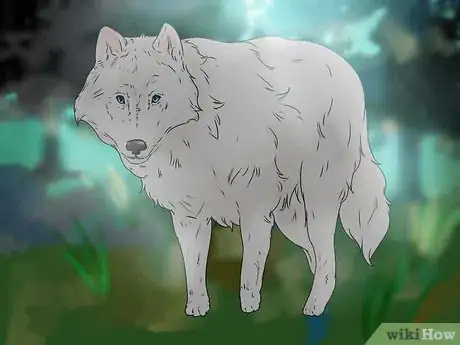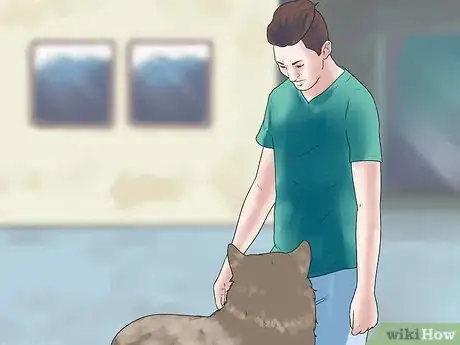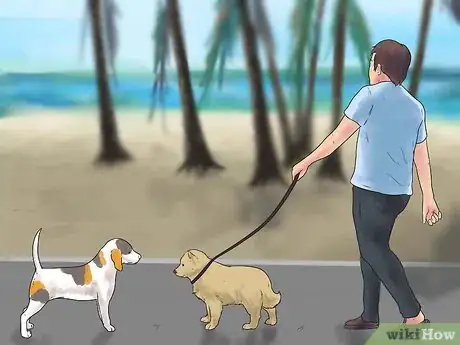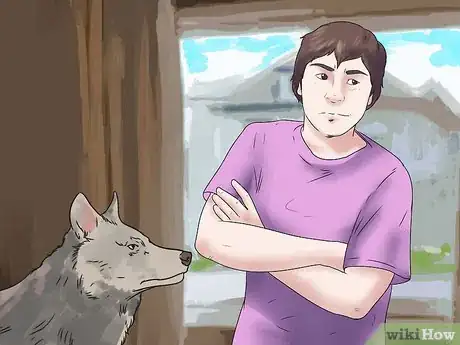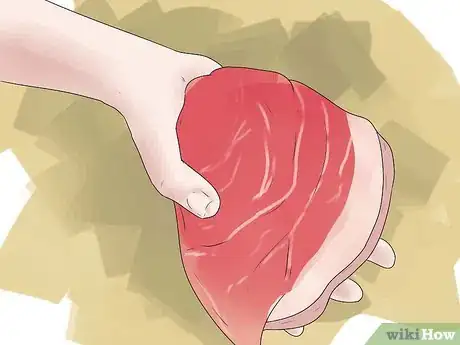wikiHow is a “wiki,” similar to Wikipedia, which means that many of our articles are co-written by multiple authors. To create this article, 61 people, some anonymous, worked to edit and improve it over time.
There are 7 references cited in this article, which can be found at the bottom of the page.
wikiHow marks an article as reader-approved once it receives enough positive feedback. This article received 31 testimonials and 86% of readers who voted found it helpful, earning it our reader-approved status.
This article has been viewed 683,514 times.
Learn more...
Are you interested in keeping a pet wolf? Or a wolf-dog hybrid? Before you go buy a wolf or wolf-dog hybrid, do your homework and make sure you understand all that goes into taking care of these animals.
Steps
Preparing For the Wolf
-
1Know what a wolf hybrid is. A wolf hybrid, also called a wolf-dog, is an exotic animal that is a mixture of a domesticated dog and a wild wolf. Most consider an animal a wolf hybrid if they have a pure wolf ancestor. This wolf should be at the most 5 generations back to be considered a wolf hybrid. However, consider why do you feel the need to own a wild animal in a domesticated setting.[1] They are mostly considered companions instead of pets.
- Low Content (LC) hybrids only contain 1-49% wolf content.
- Mid Content (MC) hybrids contain 50-74% wolf content.
- High Content (HC) hybrids are 75%+ wolf. HC hybrids are almost indistinguishable from a pure wolf. They may only contain 1-3 dog traits.[2]
- While a LC hybrid won't act like a dog, they are better for someone new to wolf-dogs. They are more outgoing, easier to train, though they still have the wolf stubbornness and independence.[3]
-
2Investigate your local laws. Wolf ownership is not legal everywhere. In the United States, the legality of owning a wolf varies from state the state. Some states completely ban private ownership, some ban only certain exotic animals, others require a license, and others have no laws. Look up your state, region, or country's laws to make sure it is legal for you to own this type of animal.[4]
- Some states allow up to 98% wolf; others draw the line at 75%, 25%, or "no first generation crosses".
Advertisement -
3Consider the price. Wolves and wolf hybrids are not cheap. They average around $1500 and can go over $2000.[5] This is more expensive than most purebred dogs. Decide if that is the kind of money you would like to spend on an animal.
- There is no way to prove the animal's pedigree. Experts at Wolfdog Rescue Resources, Inc. state that over half of the wolf hybrids being kept actually possess no wolf DNA. Other experts claim that the majority of wolf dog breeders are selling "hybrids" that actually are only dogs.[6]
- When buying a wolf or wolf dog, make sure to get it checked out by an expert if at all possible. This can save you from dropping thousands of dollars on a fake.
-
4Remember that wolves are not domesticated animals. Dogs have been bred to be submissive and to assist humans; they have been bred to be pets. This process has taken 10,000 years. Wolves, on the other hand, have spent the last 10,000 years being wild. Though people keep wolves as pets when they've raised them from a puppy, they are still instinctual animals that can't completely be tamed. They're more elusive, more intelligent (which means that they can easily outsmart you), more ferocious, have a stronger prey drive and significantly more unpredictable. Consider that during breeding season your wolfdog will become incredibly agitated and may even be aggressive towards you. Consider that they often and easily destroy furniture as well as attack (and kill) dogs and other canines (since they're not domesticated, they still view them as competition for resources). There are multiple resources on owning wolfdogs - including YouTube channels, blogs and informative websites. Go to multiple and make sure they have a credible understanding of how a wolf works. [7]
- Do not take a wolf from the wild. If you are interested in owning a wolf, do not get one from the wild. Instead, adopt one from a wolf sanctuary. Taking wolves out of the wild can be very dangerous and might end in injury or even death. Wild wolves also have a natural fear or wariness around humans that captive-born pups lack.
-
5Talk to an expert. If you are still interested in owning a wolf or wolf hybrid, visit a wolf sanctuary. Many sanctuaries have both wolves and wolf dogs that you can observe. Before getting one of these exotic animals, talk to an expert at the sanctuary. They can help answer your questions, give you more information, and help you understand the responsibility that goes into owning a wolf or wolf dog.
-
6Try volunteering at a wolf center where you can get insight into how a wolf's mind works and how they act around humans. Many wolf sanctuaries all over the world have several wolfdogs because of uneducated people believing that they'll act like dogs and then dropping them off as soon as their new pet destroys their car, tries to kill something or marks territory. Wolfdogs are difficult animals to manage even for experts who've raised wolfdogs or worked with wolves for years and spending time with them will give you a good idea about what it takes it to raise one.
- Try finding wolf and wolf dog owners in your area. Contact them and arrange a meeting. They can be a valuable source of information since they own an exotic animal.
- Some of these sanctuaries rescue wolf hybrids and may let you adopt one from them.
Taking Care of Your Wolf
-
1Train the wolf. You cannot get away with buying a wolf or wolf hybrid and hoping it will figure out how to be a good pet. Wolves are not dogs. They need a lot of training to become suitable as a companion, which takes a lot of time and effort on the owner's part.
- These animals are cunning and extremely intelligent. They pose a much greater challenge than dogs. Some wolf hybrids are docile, while others are essentially wild. If you don't have the patience or time to train and care for the wolf, don't get one.[8]
- If you have never owned and trained a dog, do not attempt to get a wolf or wolf hybrid.
- Many owners who aren't prepared for their wolf or wolf dog end up either dropping them off at sanctuaries, which are already overcrowded, or taking them to the animal shelter where they will likely be put to sleep. Letting them go into the wild almost guarantees they will die. Adopting a wolf then getting rid of it does irreparable harm to the wolf. Since they are pack animals, being split from their home and pack can cause the wolf to get extreme anxiety and even fall ill.
-
2Know that affection might be confused with aggression. Wolves show affection differently than dogs. Sometimes this affection can be confused with aggression. Wolves greet each other with affection, but since they can't give hugs, they use their mouths. Wolves will chew on pack-mates' faces in greeting or as affection. [9]
- Wolves may do this to people, too. Most of the time, the wolf will approach you, touch its nose to yours, and then lick your teeth. However, if you get scared and pull away, the wolf will grab your face with its teeth to bring you back so it can greet you and show its affection.
- Wolves love small children, but they might get excited, jump on them, and try to carry them with their teeth by the head or arm. This could cause injury to the child when the wolf was only showing affection.[10]
- These demonstrations of affection can easily be confused for attacks.
-
3Build the proper living conditions. Wolves like to roam, and they will hop fences, break off chains, and dig their way out of yards. This can be very dangerous, because the wolf might be mistaken for a wild wolf or coyote and be shot. Or it might kill neighbors' livestock or pets. Never let the wolf roam free.
- LC and some MC wolves can exist in a normal fence without breaking free. MC and HC wolves are most likely to try to break free. They need 6–8 feet (1.8–2.4 m) fencing, along with other security measures. The fence cannot have any footholds for the wolf to climb because they can climb out of fenced in enclosures.[11]
- You also need to dig-proof the area you will keep the animal in.
- Some LC will break free while some HC will stay in the fence. It depends on how bad the animal wants to be free, how bored they are, and how much outside the fence excites them.
- A large fenced in enclosure is ideal. Wolves and wolf dogs need a lot of room to run and play.
-
4Socialize the wolf dog. Wolves are social, pack animals, so they require canine companionship. Just as important is socializing your wolf or wolf dog to people and places at a very young age. This starts training the wolf or wolf dog to be around people in a domesticated setting.
- The wolf dog needs to be taken from its mother at 2 weeks old and bottle fed. They need to immediately start being socialized to both male and female humans so they will be used to humans for the rest of their life.
- Wolves need another canine for companionship and to meet their emotional needs. You need to place the wolves with another canine of the opposite sex around the same size. This ensures the wolf or wolf dog will not be lonely.
-
5Become the Alpha. You have to be the Alpha of your wolf. When the animal is a puppy, start training them to submit on cue. This doesn't mean that the adult will always submit - wolves are very independent and self-assured. But the wolf or wolf dog will know you are the Alpha and the one in charge.
- While training the pup, never hit, bite, shout, or pin or shake the puppy by the scruff. Wolf parents don't punish their pups for chewing and biting; they are very tolerant parents. Try to refrain from physically dominating the wolf, because this could damage the relationship.
-
6Feed them the right food. Wolves exist on a meat diet. Pure wolves and HC hybrids won't be able to exist on dry dog food. Most wolves and wolf hybrids eat 2-5 pounds of meat daily.
- Venison is great for wolves. You can feed them fresh road-kill deer, but this requires a permit.
-
7Provide entertainment for the wolves. Wolves can get very bored, which could result in them breaking free from their enclosure to find stimulation. Build things inside their enclosure area to keep them active, like platforms. Wolves need to be mentally stimulated on a regular basis.[12]
- Make sure there are trees around and use old logs to hide treats inside.
- Another good idea is providing swimming areas, like water troughs, swimming pools, creeks, or ponds, for them to lay in and to dig inside.
- Sandboxes or dirt piles are great for them to dig in.
- Leash train them as pups so you can take them out on a leash. You should use two leashes when you walk them - one on the collar or harness, the other a slip leash. You should walk them every day.[13]
-
8Make sure you have available veterinarian care. Most vets don't know how to care for wolves or wolf dogs. Many will even refuse to provide treatment on these types of canines.[14] Make sure to find a vet who will care for your wolf before you purchase one.
Community Q&A
-
QuestionIs one acre of land enough space for a wolf?
 Community AnswerYes, that should be plenty of space for your wolf. Just make sure that the area is properly fenced.
Community AnswerYes, that should be plenty of space for your wolf. Just make sure that the area is properly fenced. -
QuestionWhat if the wolf attacks me because I don't feed it or care for it?
 Community AnswerIf you are not going to feed or take care of it, then you should not get a wolf (or any other animal).
Community AnswerIf you are not going to feed or take care of it, then you should not get a wolf (or any other animal). -
QuestionHow long do wolves typically live?
 Community AnswerThe common grey wolf (Canis lupus) can live for seven years in the wild and up to 17 years in captivity.
Community AnswerThe common grey wolf (Canis lupus) can live for seven years in the wild and up to 17 years in captivity.
References
- ↑ http://thebark.com/content/do-wolfdogs-make-good-pets?page=2
- ↑ http://www.dogbreedinfo.com/w/wolfdog.htm
- ↑ http://www.dogbreedinfo.com/w/wolfdog.htm
- ↑ http://www.bornfreeusa.org/b4a2_exotic_animals_summary.php
- ↑ http://www.nextdaypets.com/Wolf-Hybrid.htm
- ↑ http://thebark.com/content/do-wolfdogs-make-good-pets?page=2
- ↑ http://www.onegreenplanet.org/animalsandnature/so-you-want-a-pet-wolf/
- ↑ http://www.onegreenplanet.org/animalsandnature/so-you-want-a-pet-wolf/
- ↑ http://www.graywolfconservation.com/Captivity/wolves_as_pets.htm
- ↑ http://www.missionwolf.org/page/wolf-dog-questionnaire/
- ↑ http://www.dogbreedinfo.com/w/wolfdog.htm
- ↑ http://www.missionwolf.org/page/wolf-dog-questionnaire/
- ↑ http://www.dogbreedinfo.com/w/wolfdog.htm
- ↑ http://www.missionwolf.org/page/wolf-dog-questionnaire/
- ↑ http://www.dogbreedinfo.com/w/wolfdog.htm
About This Article
To own a pet wolf, start by researching your local laws to make sure it’s legal to own one where you live. Then, talk to an expert or volunteer at a wolf center before you buy one so that you know what to expect when trying to raise a wolf as a pet. If you are still up for it, buy your wolf from a reputable source, and have it checked out by an expert since there’s no real way to prove a wolf’s pedigree. Once you’ve bought a wolf, expect to spend a lot of time training it to be docile and establishing yourself as the leader of its “pack.” For tips on how to feed your pet wolf, read on!



